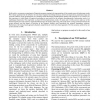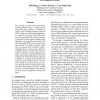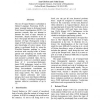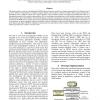80 search results - page 8 / 16 » Simple Features for Chinese Word Sense Disambiguation |
LREC
2010
13 years 8 months ago
2010
In this article, we present an experiment of linguistic parameter tuning in the representation of the semantic space of polysemous words. We evaluate quantitatively the influence ...
ECAI
2000
Springer
13 years 11 months ago
2000
Springer
Abstract. This paper describes an experimental comparison between two standard supervised learning methods, namely Naive Bayes and Exemplar–basedclassification, on the Word Sens...
EMNLP
2008
13 years 8 months ago
2008
The accuracy of current word sense disambiguation (WSD) systems is affected by the fine-grained sense inventory of WordNet as well as a lack of training examples. Using the WSD ex...
COLING
2008
13 years 8 months ago
2008
The use of topical features is abundant in Natural Language Processing (NLP), a major example being in dictionary-based Word Sense Disambiguation (WSD). Yet previous research does...
LREC
2010
13 years 8 months ago
2010
This paper presents a word sense disambiguation (WSD) approach based on syntactic and logical representations. The objective here is to run a number of experiments to compare stan...




